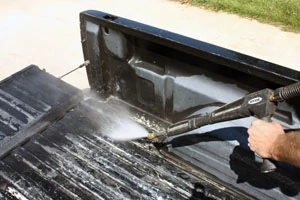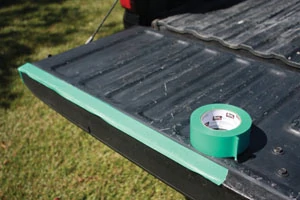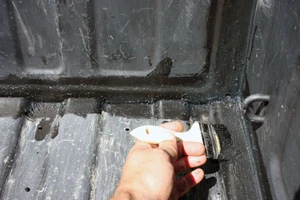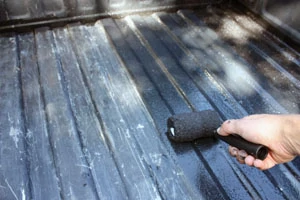By Matt Weber
I’m tough on a truck. To me, a pickup truck isn’t meant to be coddled like a toy poodle. I treat mine more like a sled dog, and although I keep the oil clean and the tires full of air, I don’t worry much about the exterior, particularly not the hauling surface of the truck bed. However, every once in a while it pays to give the bed a little TLC, to preserve its integrity so I can go right back to not worrying.
A liquid bed liner permanently bonds to the surface to provide a hard, non-skid surface that won’t warp or crack and helps prevent rust on your truck bed. These roll-on or spray-on products have a high content of solid material to create a textured surface that helps prevent slips and falls and shifting cargo. Plus, the new coating renews the appearance of the bed for a fresh from-the-dealership look.
The bed of my 2006 Silverado had seen a lot of wear. I’ve used it to haul gravel, lumber, soil, compost, concrete, crossties, cinder blocks, flagstone, power tools and paint. The harder and heavier material contributed lots of scratches and abrasions to the bed’s factory finish, and the occasional disaster with a poorly sealed paint canister had left a considerable mess on the metal floor. As with any painting project, the application of a liquid bed liner requires careful surface preparation.


Hopefully your truck bed hasn’t endured the same savagery as mine, which demanded a lot of extra work. Removing the old paint was an hours-long ordeal. I began by washing the bed with a pressure washer. I then scraped away the worst of the caked paint with the blade of a 10-in-1 tool. The channels in the bed of the pickup were only about 2 in. wide, so a narrow scraper blade was required to fit into the lower grooves. I followed that chore by scrubbing the remaining paint with an abrasive pad and a paint-stripping solvent.
If there’s no spilled paint to remove, you can begin the job with the next step: rust removal. Despite the many scratches to the paint, corrosion had not yet become a major issue. Left untreated rust can eventually eat through the metal of the bed, which is the primary reason I was applying the new coating. Luckily it didn’t take long to sand the occasional rust spot clean. Bare metal can be primed before application of the bed liner coating. Check with the liner manufacturer for recommendations on suitable primers.

Before painting the bed, every square inch must be scuff-sanded for better adhesion of the liquid liner. This does not require removal of the paint, but does require some light abrasion so the liner gains a better bond with the original finish. Once the entire surface has been scuffed, thoroughly pressure-wash the truck bed or wipe down with a rag and rubbing alcohol.

Mask off the bed with painter’s tape to protect all other areas of the truck from contact with the liquid liner.
Some brands of liquid bed liners can be applied by aerosol can, others only by professionals. This article details a product called Plasitikote Truck Bed Liner (www.plastikote.com), targeted to the do-it-yourself market, which is applied with a brush and paint roller.

Begin by stirring the liquid liner thoroughly to mix the rubber granules evenly into the paint from where they’ve settled on the bottom of the can. Begin by using a 2-in. paint brush to apply the liquid liner along edges of the bed and inside corners that will be difficult to access with a paint roller.
Next, pour a pint of liquid liner into a paint tray and apply a thin coat over the entire surface of the bed using a 4-in. paint roller. The 4-in. size does a better job of fitting into the channels and various contours of the truck bed than a standard roller. Work from the front of the bed toward the back, overlapping the roller strokes. Allow the first coat to dry for 20 minutes, and then follow with a second coat. Apply the second coat from the sides of the bed, which may require a stepladder. After the second coat dries, repeat for a third coat.


Note: After beginning application in the direct sunlight, I noticed the heat of the sun would dry the product a little too quickly, causing the liquid to clump. To solve this I moved the truck into the shade and got a longer working time from the liquid liner, making application easier and less messy.
Allow the bed liner to dry overnight, remove the masking tape and it’s ready for use. The new liner was a shiny, uniform and continuous hardened shell completely coating the bed surface to protect the metal from the rigors of hard work.
SIDE NOTE
LINE-X Spray-On Bedliner
For a professional installation, Line-X is the leading U.S. provider of spray-on protective coatings. Specialized equipment is combined with the right materials and product knowledge to produce sprayable elastomeric coatings. All systems utilize a two-component, spray-in-place, 100-percent solids (no air pollution), thermoplastic polyurethane and polyuria coating. The recently launched Line-X Premium product is a zero-VOC coating that provides superior ultraviolet (UV) stability with excellent color and gloss retention. Visit www.linex.com.



